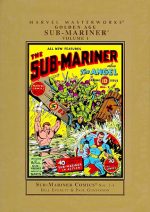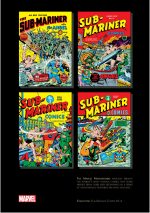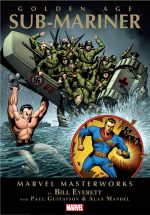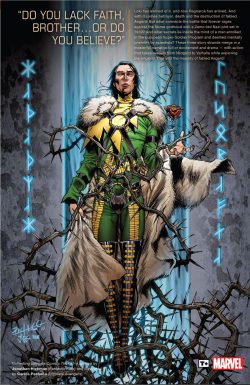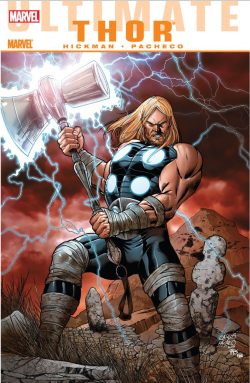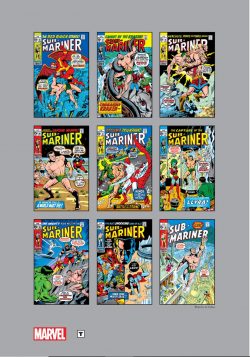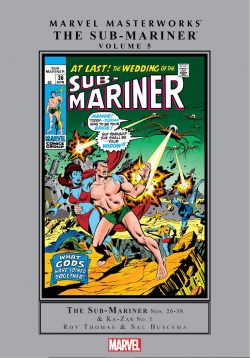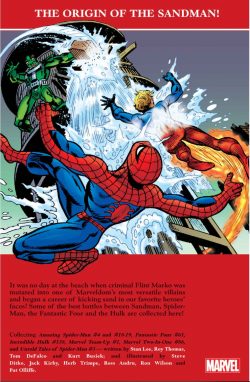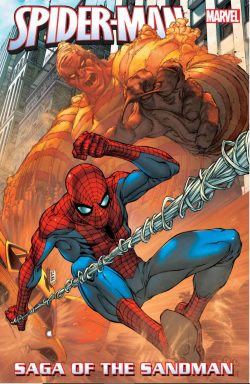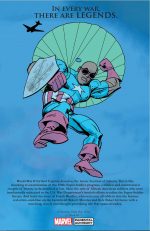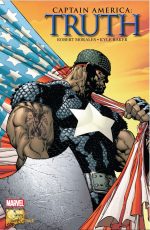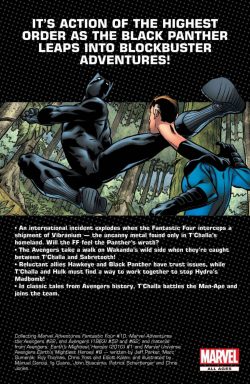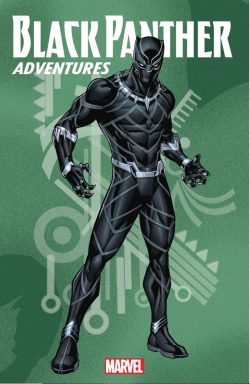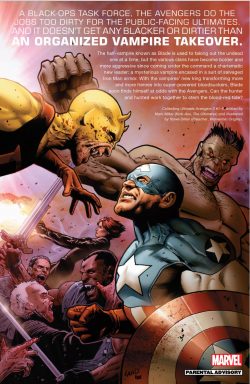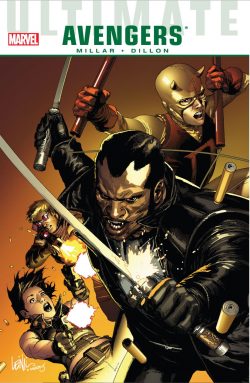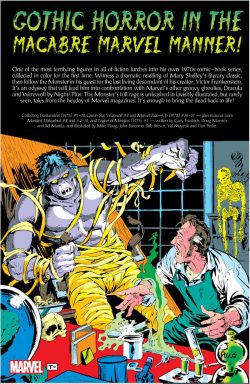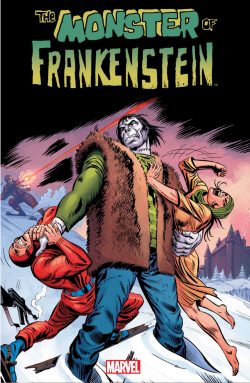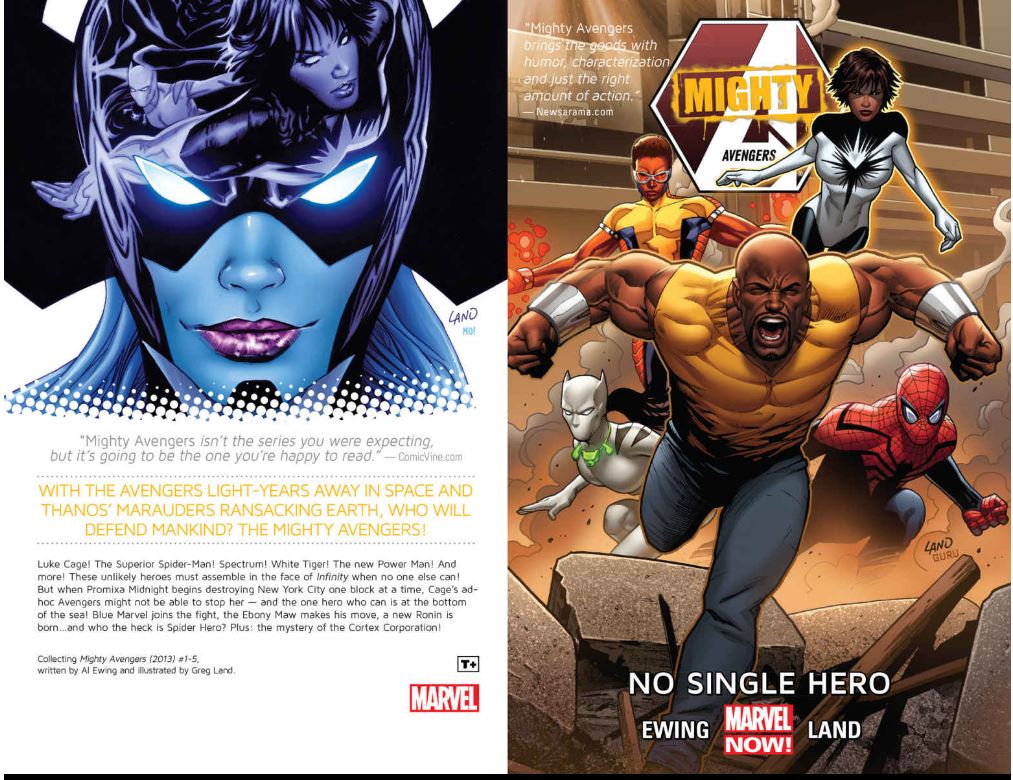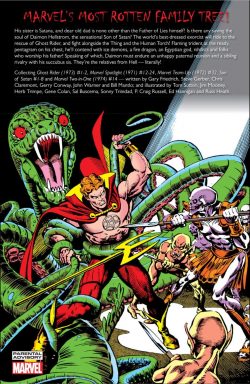
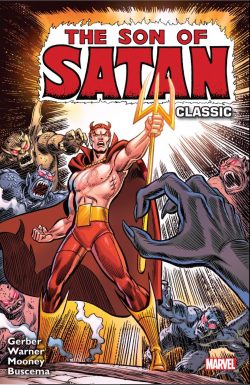
By Gary Friedrich, Steve Gerber, Gerry Conway, Chris Claremont, John Warner, Bill Mantlo, Mike Friedrich, Herb Trimpe, Tom Sutton, Jim Mooney, Gene Colan, Sal Buscema, Sonny Trinidad, P Craig Russell, Ed Hannigan, Russ Heath, Jim Starlin & various (Marvel)
ISBN: 978-3029-0104-2 (TPB/Digital edition)
As the 1960s closed, American comics were in turmoil, reflecting the greater society they were being published in – the one full of reactionary establishment types, turbulent rebellious youth, black people and their multi-ethnic supporters all agitating for universal Civil Rights and impressionable kids looking for entertainment and getting an education along the way.
In that cauldron – one fully addressed and depicted in comics books as much as laws and the Comics Code would allow – dissatisfaction and the need for change permeated everyone’s mind and the desire for a new way gripped the national and international consciousness.
Superheroes had dominated for most of the decade: peaking globally with a rush of outrageously daft, “Camp” humour excess before explosively falling to ennui and overkill. Business never sleeps, however, and in their place, TV, movies and comics returned to familiar old genres like westerns, war, science fiction and especially horror stories: although these too benefitted from and were changed by expanded consciousness and enlightened social attitudes.
For Marvel, the problem must have been particularly acute: Stan Lee & Jack Kirby had rebuilt an ailing minor publisher into a close contender for the top spot, on the backs of gaudily attired mystery men, but now that the bubble seemed to have both deflated and burst… for a second time.
Since other genres were now piquing the still-presumed mostly adolescent interests of comics core readership – like the alternative “cool” vibe attached to the modern notion of disenchanted, unchained youth (and generally ones riding motorbikes) – all publishers were looking for fresh and different ways forward.
To counter the abrupt downturn in superhero sales, the Comics Code prohibition against horror stories and iconography was hastily amended to facilitate the resurrection of scary material and bolster an industry in economic freefall. With terror tales and magical situations back in a big way, a new crop of anthologies and supernatural heroes and monsters started to thrive, supplementing the ghosts, ghoulies and goblins that had been gradually infiltrating the formerly science-only scenarios of the superhero who had weathered the downturn by tackling horror themes and villains…
It should be noted that more mature scary stories had been available since the mid-60s in the monochrome publications of Jim Warren and his imitators, who had deftly sidestepped Comics Code embargos by redefining their graphic output as “magazines” not comics. Now the likes of Eerie and Creepy had some real competition…
Lifting the CCA ban sparked a mass spawning of horror titles of varying degrees of potency and excess. Whether new material or reprints from before and after the instigation of the Code, the inexorable wave of thrillers and chillers helped even more venerable costumed crusaders close their doors and – temporarily at least – bite the dust.
Almost overnight, nasty monsters became acceptable fare on four-colour pages and a parade of pre-code reprints refreshed jaded palates whilst making sound financial sense. However, the creative aspect of the contemporary fascination with supernatural themes was best catered to by adapting already-popular and well-known cultural icons (all long out of copyright) before gambling on new concepts and an untested readership.
Whereas DC quickly cornered the market in new anthology tales – in the mordantly dark vein of Poe, Lovecraft, M.R. James, Algernon Blackwood, Ambrose Bierce, O. Henry and more – Marvel’s attempts at new, stand-alone anthological vehicles proved less successful and they soon shifted editorial efforts to their strong suite: developing ongoing characters in a shared universe. centred
The House of Ideas combined the new trend with their established style to create dark and tragic adventure heroes and even explored having unrepentant villains – like Dracula – as chief protagonist. As always in entertainment, the watchword was fashion: what was hitting big outside comics must be adapted and incorporated into the continuity. Marvel was still reeling from Kirby’s defection to DC in 1970 (where he would conjure his own chilling legends with Spirit World and The Demon) and new Editor-in-Chief Roy Thomas cannily greenlit a new character combining freewheeling, teen-friendly biker themes with the all-pervasive horror-furore…
Are you up for a bit more context before we really begin?
When proto-monster star Morbius, the Living Vampire debuted in Amazing Spider-Man #101 (cover-dated October 1970) and the sky failed to fall in, Marvel moved quickly and instituted a string of shocking super-stars. The began with a tragic wild beast and cruelly cunning predator – Werewolf by Night and The Tomb of Dracula – before chancing something truly new: a devil-haunted biker who could tap into both the motorcycling chic of movie Easy Rider and the global supernatural zeitgeist.
Preceded by god-touched western star Red Wolf and the aforementioned Werewolf by Night a new Ghost Rider premiered in Marvel Spotlight #5 (August 1972), and in turn led to the birth of the troubled subject of this Classic collection.
The graphic grimoire gathers the earliest exploits of Daimon Hellstrom as first seen in Ghost Rider #1-2, Marvel Spotlight #13-24, and Son of Satan #1-8, plus pertinent crossovers from Marvel Team-Up #32 and Marvel Two-In-One #14. Said saga spanned September 1973 to February 1977.
And will need even more background to with your continued indulgence…
Stunt-biker Johnny Blaze sold his soul to Satan to save his adopted father-figure Crash Simpson from cancer, but was cheated by the Devil. When the Lord of Lies came to collect his due, Johnny’s devoted and virginal girlfriend Roxanne Simpson interceded and partially redeemed her man. Although her purity prevented Satan’s victory, the Devil was only temporarily thwarted and took a measure of vengeance by afflicting Blaze with a body that burned with the fiery torments of Hell every time the sun set…
Initially haunting the night and terrorising thugs and criminals, the traumatised biker soon left the city for the solitary desert, perpetually battling The Deceiver’s countless agents who were tasked with shattering Roxanne’s loving aura of protection and claiming Blaze for Hell.
As part of these adventures Blaze battled a diabolical cult led by First Nations medicine man Snake Dance who sought to sacrifice Roxanne. The Ghost Rider barely saved her and – after dodging gun-happy cops – rushed her to hospital, where he was again attacked, this time by the Medicine Man’s daughter, Linda Littletrees, who revealed her own intimate connection to the Infernal…
The confrontation culminated in a devastating eldritch assault as she revealed her hidden role as satanic siren Witch-Woman…
That epic duel opens this compendium with Ghost Rider #1 (cover-dated September 1973, by Gary Friedrich, Tom Sutton & Syd Shores), further extending the escalating war between Blaze and the Devil and using the conflict to introduce a new horror-hero who would take over the biker’s vacant slot in Spotlight: one owing much to the tone of the times and the imminent release of movie blockbuster The Exorcist…
It transpires that Linda Littletrees isn’t so much a Satan-worshipping witch as ‘A Woman Possessed!’, but when her father and her fiancé Sam Silvercloud call in a Boston-based exorcist named Daimon Hellstrom, they are utterly unprepared for the kind of assistance this demonologist offers.
A Roxanne slowly recuperates, Blaze is still on the run from the police and Ghost Rider #2 sees the bedevilled biker dragged down to Hell in ‘Shake Hands With Satan!’ (illustrated by Jim Mooney & Shores) before the tale concludes in Marvel Spotlight #12 with the official debut of ‘The Son of Satan!’, courtesy of Friedrich, Herb Trimpe & Frank Chiaramonte.
Here it is revealed that religious scholar Hellstrom has a long and painfully suppressed inner self, and that the exorcist is actually a brutal scion of the Infernal Realm eternally at war with his diabolical dad.
Unleashed and liberated, the Prince of Hell swiftly rushes to Blaze’s aid – although more to spite his sire than succour the victim – and, with his own series off to a spectacular start, continues to take the pressure off the flaming-skulled hero.
We learn that the star-crossed career of the perpetually divided champion is comprised of a war between a devout demonologist and the Prince of Pandemonium: a studious, spiritual scholar sharing one body with a rebellious, sadistically violent demonic alter ego dubbed “the Darksoul”, and the Devil’s true spawn and legacy…
Friedrich, Trimpe & Chiaramonte reveal the source of the conflict in Marvel Spotlight #13’s as ‘When Satan Walked the Earth!’ takes Hellstrom back to the house he was reared in to find and read his mother’s diary.
Victoria Hellstrom’s words describe an enigmatic, beguiling stranger who swept her off her feet and subsequent early years of wedded bliss. How she bore a son and, three years after, a daughter. The toe shifts as the writer notes her husband’s increased absences, and the day she found her man and his girl-child performing a macabre blood-oath ritual sacrifice in the cellar of the idyllic family home…
When her spouse revealed himself as Satan Incarnate, the writer went quite mad.
With his mother institutionalised, his sister taken into care and their father vanished, the grieving shellshocked son entered a seminary and studied for the priesthood.
The diary ends with the writer’s death, but Daimon’s reawakened memories stir and he recalls how, on his 21st birthday his heritage came for him. Following an irresistible call, the student followed a disembodied voice through portal to Hell and saw his father once more…
Offered all the twisted power and malign glory of a seat by the Devil’s side, Hellstrom rebelled, rejecting and battling his father and triggering a short-lived revolution in The Pit, before escaping with Satan’s all-powerful infernal Trident. The unique pitchfork is made of exotic mineral Netheranium: the only substance (other than prayer, piety, devotion and that other holy stuff) that can weaken the Devil. Best remember this is a comic book, and notionally an all-ages one at that…
Thus, after an untold age suppressing his own dark passenger, Daimon Hellstrom reaches an accommodation with his other self and prepares to take the war to the father they both despise…
At this time, Steve Gerber was Marvel’s undisputed Wizard of Weird: a brilliant, erudite, sensitive and ingenious writer who could make almost any off-the-wall concept accessible to readers – everything from Man-Thing to Howard the Duck, Daredevil to Sub-Mariner, Marvel Two-In-One to Iron Man.
He assumed the writer’s reins with Marvel Spotlight #14, joining artists Mooney & Sal Trapani in lying out a career path for the infernal antihero. It began with ‘Ice and Hellfire’ as the demonologist relocated to St. Louis, Missouri, at the request of Gateway University parapsychologist Dr. Katherine Reynolds. She has been terrorised and terrified by a string of bizarre apparitions and periodic poltergeist phenomena plaguing the campus…
Hellstrom soon uncovers an infestation of Ikthalon ice demons, and that these vile visitors and frozen furies are not invaders but have been summoned. In order to defeat them he takes Reynolds into his confidence and is enraged but unsurprised when she fails him…
Resorting to his father’s tactics to repulse the demons, Hellstrom sticks around for reasons he cannot fathom, and #15 (an all-Mooney art job) sees him endure a sinister physical change as a monstrous – possibly prophetic – dream propels him into a state of permanent chaos as his divergent natures fully merge into one eternally warring personality.
Accepting a lecturer’s position at Gateway, Hellstrom then disrupts an undergraduate ‘Black Sabbath’ and clashes again with his father – in his demonic iteration Baphomet – to save the souls of some stupidly curios students…
Trapani inked #16 as ‘4000 Holes in Forest Park!’ lure the exorcist into a very public media circus when a mysterious overnight event entices every kind of whacko out of the woodwork… as well as far less harmless loons like Christian End-Timers and a depraved Legion of Nihilists…
Inevitably the park explodes into a religion-fuelled riot, and when the Son of Satan intervenes, his supernal hellfire gimmick only exacerbates matters, igniting the scattered holes to form a colossal blazing pictogram. When the image then materialises into physical life, Dr. Reynolds and Divinity student Byron Hyatt are hurled back in time to the days before Atlantis sank, resulting in a shattering confrontation and startling glimpse at how magic reshaped the world in MS #17’s ‘In the Shadow of the Serpent!’ Schooled by legendary sorceress Zhered-Na, Hellstrom learns the necessity of catastrophe and the cosmic purpose of disaster, as well as his true role in existence before returning to the present with his fellow voyagers.
Gene Colan stepped in with #18, and – inked by Chiaramonte – takes the exorcist into a ‘Madhouse!’ when Katherine drags Daimon to a party attended by faculty and fellow parapsychologists only to find the festivities befouled by an act of animal cruelty.
The next morning Hellstrom learns that the house burned down after he left, and – curiosity aroused – investigates the ruins and detects psychic evil of tremendous potency. The fresh trail leads to young Melissa who has become the new home of truly ancient evil…
However, even after seemingly banishing ghastly Allatou back to damnation, the rescue mission continues as #19 (inked by Mike Esposito) then pits the exorcist against the girl’s fully-occupied parents in ‘Demon, Demon, Who’s Got the Demon?’: a brutal struggle that only ends when Daimon abandons holy lore and crushes his opponent with the Devil’s despised power and tactics…
Sal Buscema & Al McWilliams limned #20 as ‘The Fool’s Path!’ sees Satan’s Son targeted by a bizarre tarot reader and attacked by her animated cards. Three covers from previous SoS collections then offer a brief pause before #21 concludes the manic mystery in ‘Mourning at Dawn!’ with Joe Giella inks – exposing Madame Swabada’s incredible true nature… The battle concludes in the Bob McLeod inked ‘Journey into Himself!’ with Daimon corporeally confronting his past and a legion of demons and – ultimately – the true cause of all his woes…
Marvel Team-Up #32 – by Gerry Conway, Buscema & Vince Colletta – then offered a fiery collaboration between Human Torch Johnny Storm and Hellstrom. The exorcist inflicts ‘All the Fires in Hell…!’ on a demon possessing Johnny’s best pal Wyatt Wingfoot and assorted fellow members of his Native American Keewazi tribe. An era ended in Marvel Spotlight #23, as Gerber, Mike Friedrich, Sal B & Dan Green declare ‘In this Light, Darkness!’ with Hellstrom looking to conclude his unfinished business with the Legion of Nihilists before leaving St. Louis. The task is delayed when aged sage Father Darklyte seeks to test the scholar, only to be exposed for the menace he is…
The inheritor of Hell ended his tenure in Spotlight with #24 (October 1975) as Chris Claremont, Buscema & McLeod made him ‘Walk the Darkling Road!’ after mortal satanist Gloria Hefford summons Kthara, the Mother of Demons. Travelling to Los Angeles, Daimon seeks to save her, but is manipulated into clashing with his despised younger sister Satana: a girl after her daddy’s heart…
Even after uniting to stop Kthara, no bridges are built or fences mended between the infernal siblings…
The dispossessed Dauphin of Darkness moved into his own place as – cover-dated December 1975 – The Son of Satan #1 proclaimed ‘The Homecoming!’ as scripter John Warner, splash page artist Jim Starlin and story illustrator Jim Mooney took the eccentric exorcist into strange new territory as Hellstrom returned to the family house only to find it defiled. By invading Hell, he then learns that civil war has come to the pit as his father struggles against a usurper called The Possessor: a human who can control demons…
The war spreads, enveloping a well-meaning Navajo shaman in ‘The Possession!’ – illustrated by Sonny Trinidad – and emptying his village of living souls. As Hellstrom probes the history of the Possessor his inquiries take him back to Hell where the deranged super-psychic has his tool Nightfire lead ensorcelled tribesmen in an attack on the infernal hierarchy that the exorcist is barely able to stop in concluding clash ‘Demon’s Head’…
Another brief diversion takes us to Marvel Two-In-One #14 where Bill Mantlo, Trimpe & John Tartaglione take Ben Grimm to a western ‘Ghost Town!’ for a spooky encounter with spectres and demons. The notoriously superstitious Thing thought he was on a mission of mercy, but needed much merciful magical assistance from exorcist Daimon Hellstrom to escape the deadly grip of sinister spectre Jedediah Ravenstorm…
The final days of Daimon begin in SoS #4 as Warner, P. Craig Russell & Trinidad form a ‘Cloud of Witness!’ when the scholar returns to academia and meets Georgetown (that’s Washington DC) educator Saripha Thames. He believes he’s a specialist researcher, but is unaware that a hidden mastermind is actually studying him under laboratory conditions…
As always, plagued by incomprehensible dreams, Hellstrom gets an inkling of what’s in play when he’s accosted by higher being the Celestial Fool and challenged over his dual nature…
The mental and spiritual assault intensifies in ‘Assassin’s Mind’, with Daimon apparently unable to control his powers or Darksoul, even as new nemesis Mindstar ups the cosmic stakes before #6 begins pulling the strands together in ‘House of Elements!’ (pencilled by Ed Hannigan).and the mystery is explosively resolved in #7’s ‘Mirror of Judgement!’ by Warner & Trinidad.
The series concluded on an artistic high with #8 as Mantlo and Russ Heath – with additional art from John Romita – offered a treatise on temptation as a disturbing phantom begs ‘…Dance with the Devil My Red-Eyed Son!’. By dragging the Son of Satan through the inferno and history’s greatest flashpoints, someone attempts to seduce and soil his soul. Ultimately however, who can say who tempts whom?
This bombastic broadside of metaphysical mastery also includes the Son of Satan Preview article from Monsters Unleashed #3; Comics Code rejected pages, art from Official Handbook of the Marvel Universe entries and a selection of reprint covers to complete a superb journey to Comics’ darkest side.
One final note: backwriting and retcons notwithstanding, Christian boycotts and moral crusades of a later decade compelled increasingly criticism-averse controversy-shy, commercially astute Corporate Marvel to “translate” the biblical Satan of these tales into watered-down generic and apparently more palatable demonic analogues like Mephisto, Satannish, Marduk Kurios and other equally-naff downgrades. Never forget, however, that the original intent of Ghost Rider, spin-offs Daimon Hellstrom and Satana was to tap into the era’s global fascination with supernature and satanism, which had begun with epochal films and novels like Rosemary’s Baby. Please remember these aren’t your modern and feeble Hell-Lite horrors, but concern the real-deal Infernal Realm (as much as the Comics Code would allow) and reflect good people struggling to save their souls from bad breaks and Faustian bargains, so brace yourselves, hold steady and accept no supernal substitutes…
2016 Marvel Characters, Inc. All rights reserved.
